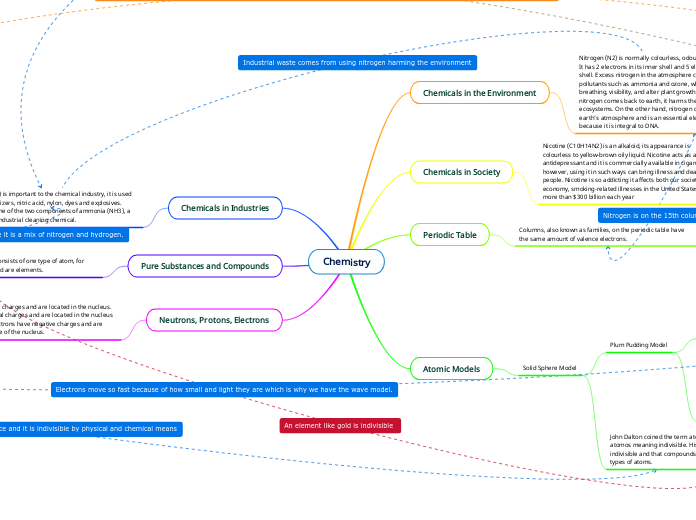
Nitrogen (N2) is normally colourless, odourless, and tasteless. It has 2 electrons in its inner shell and 5 electrons in its valence shell. Excess nitrogen in the atmosphere can produce pollutants such as ammonia and ozone, which can impair our breathing, visibility, and alter plant growth. When the excess nitrogen comes back to earth, it harms the health of our ecosystems. On the other hand, nitrogen constitutes 78% of earth’s atmosphere and is an essential element for life because it is integral to DNA.
Oxygen (O2) is a diatomic gas. It is a colourless, odourless, tasteless, gas. Oxygen has 8 protons, neutrons and protons. Oxygen is what makes us breathe which is very, very important. Oxygen also exists as ozone forming the ozone layer - protecting us from the harmful ultraviolet rays of the Sun. Oxygen also makes up water. Oxygen is a fire accelerant, so during wildfires it can amplify the damage dealt.
Methane (CH4) is colourless, odourless, and flammable. When methane is produced from non-fossil sources, it takes carbon out of the air providing a great environmental benefit. Greenhouse gases like carbon dioxide and methane are crucial to keep our planet at a suitable temperature for life
Water (H2O) is one of the main components of life. Water has 8 protons, neutrons and electrons. It nourishes entire ecosystems sustaining animals and plants. In simple terms, water is the building block of life. However, water can get polluted by our fossil fuel sources, this kills marine life and reduces the amount of freshwater we have.
Nicotine (C10H14N2) is an alkaloid, its appearance is colourless to yellow-brown oily liquid. Nicotine acts as an antidepressant and it is commercially available in cigarettes, however, using it in such ways can bring illness and death to people. Nicotine is so addicting it affects both our society and economy, smoking-related illnesses in the United States cost more than $300 billion each year
Tanks of oxygen (O2) are used in medicine to treat people with breathing problems. Especially during our current pandemic, we use oxygen in ventilators to help pump oxygen for people in the ICU. More mechanical uses of oxygen include scuba divers needing to use tanks of oxygen and astronauts on the ISS.
One of the primary sources of methane (CH4) are the organisms living on Earth. Specifically, our cattle produce a substantial majority of methane. What this means is that as our population and food needs increase, the amount of methane will also increase. Society’s needs directly affect the amount of methane on the Earth.
Columns, also known as families, on the periodic table have the same amount of valence electrons.
With metals, the reactivity increases as the atomic number increases in the column. On the other side, the non-metals are opposite, the smaller atomic number is the most reactive.
Elements also share similar properties within a family. Gold, silver, and copper are in the same family. Their properties include good conductivity, not reactive, soft, ductile and malleable.
The number of shells needed to organize the electrons using the Bohr-Rutherford model depends on the row the element is in. The electrons will increase as you go further down the periodic table, meaning that the most dense elements are arranged at the bottom.
Solid Sphere Model
Plum Pudding Model
Nuclear Model
Planetary Model
Quantum Model
Schrodinger stated that electrons do not move in set paths/orbits like Bohr said. Instead, it moves around in waves because it is impossible to pinpoint the exact location of an electron.
Bohr thought of the atom model similar to our solar system, with electrons orbiting in shells around the nucleus in fixed sizes and energies.
Rutherford conducted a gold foil experiment in which he discovered that positive charges were localised in the nucleus of an atom.
Thomson discovered electrons and referred to them as plums in a pudding, circling around the cloud of positive charge.
John Dalton coined the term atom from the Greek word atomos meaning indivisible. His theory is that atoms are indivisible and that compounds are combinations of different types of atoms.
Nitrogen (N2) is important to the chemical industry, it is used to make fertilizers, nitric acid, nylon, dyes and explosives. Nitrogen is one of the two components of ammonia (NH3), a widely used industrial cleaning chemical.
Oxygen (O2) has numerous uses in steelmaking and other metals refining and fabrication processes, in chemicals, pharmaceuticals, petroleum processing, glass and ceramic manufacture, and pulp and paper manufacture.
Methane (CH4) that is released into the atmosphere before it is burned is harmful to the environment. Due to high amounts of methane being released into the atmosphere, the Earth is becoming warmer than it naturally is. Methane from fossil fuel sources is one of the primary contributors to global warming
An element is matter that consists of one type of atom, for example, aluminum and gold are elements.
A mixture of two or more elements that are chemically bonded together. A big example is water, the water molecules are not separated, unlike regular mixtures.
A compound like water is made up of hydrogen and oxygen, two different elements that are chemically bonded. Pure substances are made up of one type of atom that is uniform throughout. You are able to distinguish between compounds and pure substances by knowing the amount of elements.
A pure substance cannot be separated into 2 or more substances by physical means such as crystallization or distillation nor by mechanical means such as sifting, filtering, or using a magnet. This is similar to our lab experiments where we used liquids and objects to chemically and physically change the substances.
Protons have positive charges and are located in the nucleus. Neutrons have neutral charges and are located in the nucleus with the protons. Electrons have negative charges and are located on the outside of the nucleus.
A proton has a relative mass of 1. A neutron has a relative mass of 1. An electron has a relative mass of 1/1836.